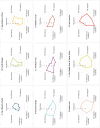Geocultural differences in preschooler sleep profiles and family practices: an analysis of pooled data from 37 countries
- PMID: 39715306
- PMCID: PMC11985386
- DOI: 10.1093/sleep/zsae305
Geocultural differences in preschooler sleep profiles and family practices: an analysis of pooled data from 37 countries
Abstract
Study objectives: To examine (1) multidimensional sleep profiles in preschoolers (3-6 years) across geocultural regions and (2) differences in sleep characteristics and family practices between Majority World regions (Pacific Islands, Sub-Saharan Africa, Eastern Europe, Northeast Asia, Southeast Asia, South Asia, the Middle East and North Africa, and Latin America) and the Minority World (the Western world).
Methods: Participants were 3507 preschoolers from 37 countries. Nighttime sleep characteristics and nap duration (accelerometer: n = 1950) and family practices (parental questionnaire) were measured. Mixed models were used to estimate the marginal means of sleep characteristics by region and examine the differences.
Results: Geocultural region explained up to 30% of variance in sleep characteristics. A pattern of short nighttime sleep duration, low sleep efficiency, and long nap duration was observed in Eastern Europe, Northeast Asia, and Southeast Asia. The second pattern, with later sleep midpoints and greater night-to-night sleep variability, was observed in South Asia, the Middle East and North Africa, and Latin America. Compared to the Minority World, less optimal sleep characteristics were observed in several Majority World regions, with medium-to-large effect sizes (∣d∣=0.48-2.35). Several Majority World regions reported more frequent parental smartphone use during bedtime routines (Northeast Asia, Southeast Asia: 0.77-0.99 units) and were more likely to have electronic devices in children's bedroom (Eastern Europe, Latin America, South Asia: OR = 5.97-16.57) and co-sleeping arrangement (Asia, Latin America: OR = 7.05-49.86), compared to the Minority World.
Conclusions: Preschoolers' sleep profiles and related family practices vary across geocultural regions, which should be considered in sleep health promotion initiatives and policies.
Keywords: behavioral sleep; cross-cultural comparison; early childhood; public health.
© The Author(s) 2024. Published by Oxford University Press on behalf of Sleep Research Society.
Figures



Comment in
-
Preschool sleep recommendations are WEIRD.Sleep. 2025 Apr 11;48(4):zsaf025. doi: 10.1093/sleep/zsaf025. Sleep. 2025. PMID: 39866143 Free PMC article. No abstract available.
Similar articles
-
Global estimates of HIV infections and AIDS cases: 1991.AIDS. 1991;5 Suppl 2:S57-61. doi: 10.1097/00002030-199101001-00009. AIDS. 1991. PMID: 1845061
-
Differences in sleep problems between Japanese and Chinese preschoolers: a cross-cultural comparison within the Asian region.Sleep Med. 2018 Aug;48:42-48. doi: 10.1016/j.sleep.2017.11.1145. Epub 2018 Jan 4. Sleep Med. 2018. PMID: 29857290
-
[Induced abortion: a world perspective].Perspect Int Planif Fam. 1987;(Spec No):12-6. Perspect Int Planif Fam. 1987. PMID: 12269047 Spanish.
-
Prevalence and number of children living in institutional care: global, regional, and country estimates.Lancet Child Adolesc Health. 2020 May;4(5):370-377. doi: 10.1016/S2352-4642(20)30022-5. Epub 2020 Mar 6. Lancet Child Adolesc Health. 2020. PMID: 32151317
-
Estimating the number of men who have sex with men in low and middle income countries.Sex Transm Infect. 2006 Jun;82 Suppl 3(Suppl 3):iii3-9. doi: 10.1136/sti.2005.019489. Sex Transm Infect. 2006. PMID: 16735290 Free PMC article. Review.
Cited by
-
Preschool sleep recommendations are WEIRD.Sleep. 2025 Apr 11;48(4):zsaf025. doi: 10.1093/sleep/zsaf025. Sleep. 2025. PMID: 39866143 Free PMC article. No abstract available.
References
-
- Lim DC, Najafi A, Afifi L, et al.; World Sleep Society Global Sleep Health Taskforce. The need to promote sleep health in public health agendas across the globe. Lancet Public Health. 2023;8(10):e820–e826. doi: https://doi.org/10.1016/S2468-2667(23)00182-2 - DOI - PMC - PubMed
-
- Hale L, Troxel W, Buysse DJ.. Sleep health: an opportunity for public health to address health equity. Annu Rev Public Health. 2020;41:81–99. doi: https://doi.org/10.1146/annurev-publhealth-040119-094412 - DOI - PMC - PubMed
-
- Khan T, Abimbola S, Kyobutungi C, Pai M.. How we classify countries and people—and why it matters. BMJ Specialist Journals 2022;7:e009704. doi: https://doi.org/10.1136/bmjgh-2022-009704 - DOI - PMC - PubMed
-
- Zhang Z, Sousa-Sa E, Pereira JR, Okely AD, Feng X, Santos R.. Correlates of sleep duration in early childhood: a systematic review. Behav Sleep Med. 2021;19(3):407–425. doi: https://doi.org/10.1080/15402002.2020.1772264 - DOI - PubMed
MeSH terms
Grants and funding
- National Research Council of Thailand
- Signe and Ane Gyllenberg Foundation
- KEM Hospital Research Centre
- APP1176858/NHMRC
- Juho Vainio Foundation
- NIH Scholarship Travel Award
- Ministry of Education and Culture in Finland
- R25 TW011215/TW/FIC NIH HHS/United States
- WHO European Office for the Prevention and Control of Noncommunicable Diseases
- Faculty of Health Sciences, University of the Witwatersrand
- Faculty of Physical Education and Sport, University of Tuzla
- 2674/Sir Halley Stewart Trust
- CREDPR PI Award
- Amsterdam Public Health Health Behaviors and Chronic Diseases Project Grant
- PFG_FULL_2022_005/World Cancer Research Fund International and Cancer Australia
- 198862/Mahidol University Fundamental Fund
- Research University Grant and Faculty of Education Grant
- A66864/TW/FIC NIH HHS/United States
- American Council on Exercise
- Samfundet Folkhälsan
- Thailand Physical Activity Knowledge Development Centre (TPAK)
- PAIDI P20_1181/Government of Andalusia, Research, Development, and Innovation Program
- Institute for Population and Social Research, Mahidol University, Thailand
- Yrjö Jahnsson Foundation
- 1320/HĐ-TĐHYKPNT/Pham Ngoc Thach University of Medicine's Fund for Science
- R25 TW011215/NH/NIH HHS/United States
- European Union - NextGenerationEU
- U.S. Department of State's Office of the U.S. Global AIDS Coordinator and Health Diplomacy (S/GAC)
- ISBNPA Pioneers Scholarship Program

